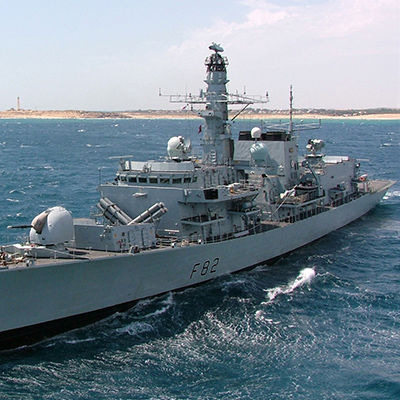Warfare
Corvette
Mohsen Shir-Muhammad
56 Views
Iranian Navy corvettes played a significant role in naval operations during the Iran-Iraq War. A corvette is a small military vessel designed for specialized missions based on its structure, equipment, and onboard weapons. Most corvettes are used for coastal operations, patrolling, and securing ports and harbors. These fast-moving vessels, though fueled by strong engines,[1] remain unsuitable for rough-sea missions. Typically, corvettes weigh between 150 and 300 tons and come in various configurations, armed with either guns or missiles.[2]
Before the war, Iran’s Navy had 3 gun-armed Bahram-class corvettes stationed in the First Naval Zone in Bandar Abbas, 4 gun-armed Mehran-class corvettes in the Third Naval Zone in Khorramshahr, and 9 missile-launching Kaman-class corvettes in the Second Naval Zone in Bushehr. In addition, 26 smaller 65-foot patrol corvettes were deployed across all three naval zones.[3]
Before the Islamic Revolution, the combination of naval aviation, missile corvettes, and naval commandos—supported by the Air Force—was considered the most effective tactical force structure for countering Iraq’s navy in the northern Persian Gulf.[4]
Iraq’s naval forces at the time included 14 Osa-class missile corvettes, 12 P-6 class fast torpedo boats, and 20 coastal patrol corvettes—all supplied by the Soviet Union. Notably, the Osa-class corvettes had greater tactical significance due to their armament, which included Styx missiles.[5]
During the war, Iran mostly used Peykan-class (Kaman-class) vessels.[6] These ships had been ordered from France in 1974;[7] nine were delivered before the Revolution, with three remaining three transferred in 1981.[8]
Another key element of Iran’s naval arsenal was the Kaman or Combatant-class missile corvettes. These ships were equipped with high-speed Harpoon anti-ship missiles, modern fire-control and electronic warfare systems, and fully automated light guns for both surface and anti-air defense.[9]
After the Revolution, due to the cancellation of arms purchases by the interim government, Iran was unable to receive the 200 Harpoon missiles originally planned for these corvettes.[10] By the time the war began, only 12 Harpoon missiles were available in the Navy’s arsenal. This was a major weakness and a significant operational limitation as each corvette could carry only one missile. As the war dragged on and several missiles were fired at Iraqi targets, some corvettes had to transfer their remaining missiles from one ship to another in order to continue their missions.[11]
The Iranian Navy’s primary tactic during the war was to lure Iraqi naval units, especially missile corvettes, out of the port of Umm al-Qasr into the Persian Gulf and then destroy them in a combined air-sea operation. In the early days of the war, when Iran’s naval units enjoyed strong air force support, they even advanced to the mouth and inside the Khor Abdullah waterway, provoking Iraqi units to come out, only to ambush and destroy them.
The primary concern for the Iranian Navy early in the war was the threat of surprise missile strikes by Iraqi corvettes targeting Iranian ports. There was a real chance that Iraqi corvettes could exploit the cover of darkness, approach Iran’s coastline via the shores of other Gulf Arab states, and attack ports such as Bandar Abbas, Bushehr, or Bandar Imam Khomeini (ra), as well as Iran’s vital oil and gas facilities in the Persian Gulf.
To prevent such a scenario, the Iranian Navy used all of its islands and offshore oil platforms in the Persian Gulf to establish an integrated and reliable surveillance and detection system, monitoring any Iraqi naval movements. Throughout the war, Iranian naval units, including missile corvettes, conducted continuous patrols from Khor Abdullah all the way to the Strait of Hormuz, keeping the area under close observation. As a result, Iraq was never able to launch a serious naval strike against Iranian ports in the Persian Gulf.[12]
On November 1, 1980, the Iranian Navy carried out Operation Ashkan, involving three Kaman-class missile corvettes (Joshan, Gardouneh, and Peykan) and an SH-3D helicopter. They shelled the al-Bakr and al-Amiyah oil platforms, damaging their facilities and causing significant destruction. During the operation, an Iraqi aircraft attempting to attack the Iranian ships was shot down by the Peykan corvette.[13]
On November 4, 1980, a special naval commando team, two missile corvettes, two SH-3D helicopters, a small vessel carrying explosives, and aircraft from the 6th Tactical Fighter Base providing air cover participated in another strike to ensure the complete destruction of the al-Bakr and al-Amiyah platforms.[14] The platforms suffered heavy damage which resulted in the total shutdown of Iraqi oil exports.[15] In the same mission, Peykan engaged and sank two Iraqi missile boats at the mouth of Khor Abdullah.[16]
On November 28, 1980, Operation Morvarid was carried out in which the Peykan corvette played a central role.[17] Supported by Iranian Air Force Phantom jets, the Joshan corvette also participated in the operation.[18] The plan included Iranian naval commandos capturing the al-Bakr platform.[19] In this decisive battle, Iranian forces destroyed 5 Osa-class missile boats, 3 fast-moving vessels, one minesweeper, one troop transport ship, and two unidentified vessels. Moreover, 3 other Iraqi boats were heavily damaged, and 11 enemy aircraft were shot down.[20]
By the end of the operation, however, Peykan was struck by Styx missiles fired from an Iraqi Osa-class boat and sank.[21] Despite the loss, Iranian Navy helicopters managed to rescue 16 crew members and commandos from the water and recover the bodies of two martyrs.[22]
After Iran’s naval operation on November 28, 1980, the Iraqi navy was forced to change its tactics thereby replacing surface units, especially Osa-class missile boats, with aerial units equipped with anti-ship missiles.[23]
With their upgraded systems and high-speed strike capability, the Peykan-class corvettes spearheaded Iran’s maritime defense, forcing the Iraqi navy to adopt a defensive posture.[24] Beyond the conflict with Iraq, the Iranian Navy also clashed with U.S. naval forces in the Persian Gulf, the peak of which was early 1988. At the time, the frigates Sahand and Sabalan and Joshan missile corvette engaged U.S. warships in an unequal battle that resulted in the sinking of Sahand and Joshan.[25]
Among the most distinguished martyrs of the war were those who served aboard Iranian Naval corvettes and participated in their key operations, including figures such as Captain Muhammad-Ebrahim Hemmati, commander of the Peykan corvette,[26] and Captain Ali Zare Nemati, deputy commander of the Joshan corvette.[27]
Following the Iran–Iraq War, Iran initiated domestic production of Peykan-class missile corvettes under Project Sina, beginning in 2003. The first of these ships was named Peykan in honor of the original vessel and was delivered to the Iranian Navy’s Fourth Naval Region in Bandar Anzali. Under Project Sina, four corvettes—Peykan, Joshan, Derafsh, and Separ—were developed for Iran’s Northern Fleet, while the Zereh corvette was constructed for the Southern Fleet and subsequently delivered to the Iranian Navy.[28]
[1] Rostami, Mahmoud, Farhang-e Vajeha-ye Nezami (Military Terms Dictionary), Tehran, Setad-e Moshtarak Artesh Jomhouri Eslami Iran, 1378, p. 835.
[2] Soleimani-Savadkoohi, Shahrokh, Az Savadkooh ta Landan va Daryaha-ye Door (From Savadkooh to London and Distant Seas), Tehran, Entesharat Amir Muhammad, 1392, p. 123.
[3] Manavi Roudsari, Abdollah, Negahi be Niroo-ye Daryayi Artesh Jomhouri Eslami Iran dar Hasht Sal Defa Muqaddas (A Look at the Navy of the Islamic Republic of Iran Army during the Eight Years of Sacred Defense), Tehran, Iran Sabz, 1397, Pp. 64-65.
[4] Ibid., p. 242.
[5] Ibid., Pp. 67, 75, 76.
[6] Zereh-e Jadid bar Tan-e Navgan-e Artesh dar Jonub (New Armor for Army Fleet in the South), Khabargozari Tasnim, 24 Dey 1399, https://tn.ai/2431639
[7] Abdi-Zadeh, Moones, Raz-e Morvarid (The Secret of Pearl), Tehran, Soore Mehr, 1395, p. 77.
[8] Manavi Roudsari, Abdollah, Ibid., p. 65.
[9] Soleimani-Savadkoohi, Shahrokh, Ibid., p. 241.
[10] Nakhoda Samadi, Vaqti Migooyand Artesh dar Jang Ghafelgir Shod, Divane Mishavam (Captain Samadi: When They Say the Army Was Surprised in the War, I Go Crazy), Khabargozari Khabar Online, 3 Mehr 1398, khabaronline.ir/xf5vk
[11] Soleimani-Savadkoohi, Shahrokh, Ibid., p. 313.
[12] Ibid., p. 316.
[13] Arasteh, Nasser, Maaref-e Jang (The War Lessons), Tehran, Iran Sabz, 1393, p. 460.
[14] Ibid., p. 461.
[15] Ibid., Pp. 462-463.
[16] Ibid., p. 462.
[17] Masbouq, Muhammad & Alireza Javaheri, Amaliat-e Morvarid (Operation Morvarid), Tehran, Markaz Entesharat Rahbordi NAHAJA, 1394, Pp. 182, 185-186.
[18] Arasteh, Nasser, Ibid., p. 465.
[19] Ibid., p. 463.
[20] Ibid., p. 467.
[21] Ibid., p. 466.
[22] Ibid., p. 467.
[23] Soleimani-Savadkoohi, Shahrokh, Ibid., p. 319.
[24] Ibid., p. 241.
[25] Mousavi, Seyyed Jalal, Ghoroub-e Sahan" (The Sunset of Sahand), Mahnameh Saf, No. 353, Esfand 1388 & Farvardin 1389, p. 46.
[26] Abdi-Zadeh, Moones, Ibid., p. 86.
[27] Barzegar, Abdolrahman, Kahnamoei (Kahnamoei), Tehran, Daftar-e Pajouhesh-haye Nazari va Motaleat-e Rahbordi NAHAJA, 1391, p. 59.
[28] Zereh-e Jadid bar Tan-e Navgan-e Artesh dar Jonub (New Armor for Army Fleet in the South), Khabargozari Tasnim, 24 Dey 1399, https://tn.ai/2431639





